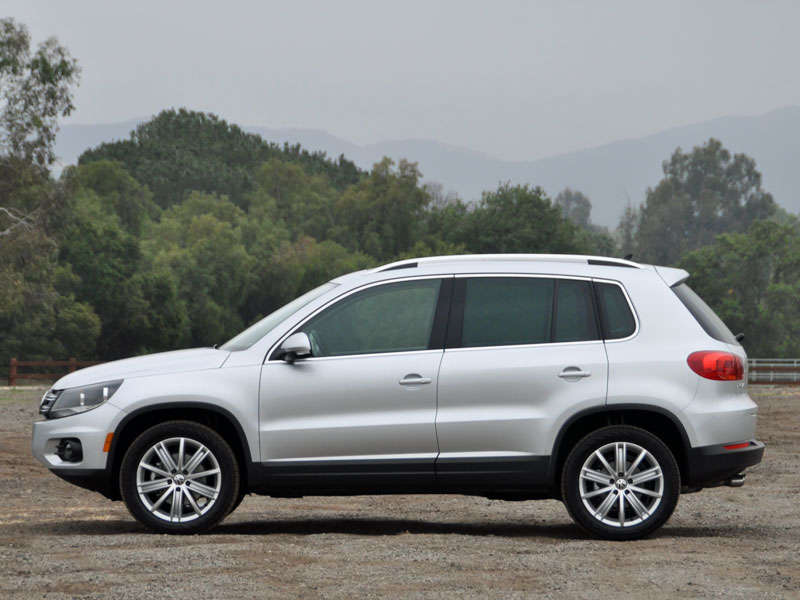Recent Articles
Popular Makes
Body Types
2014 Volkswagen Tiguan Review and Road Test
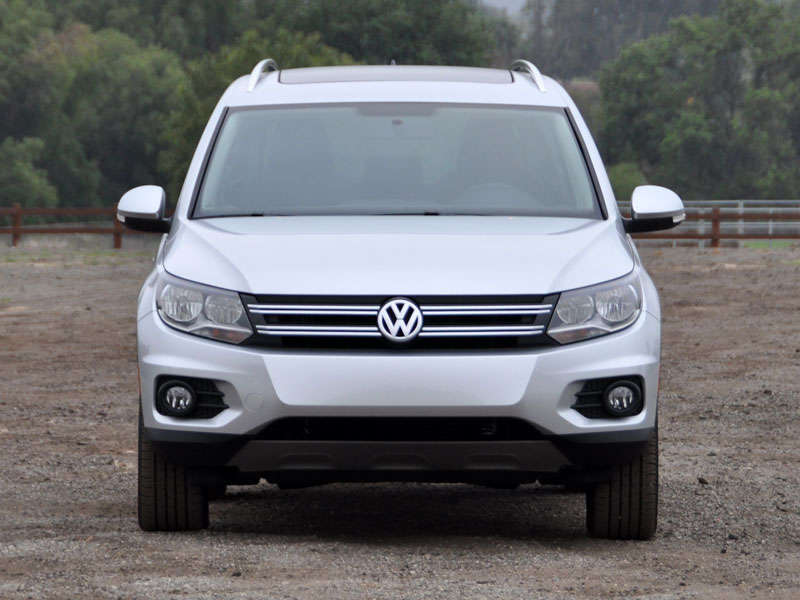
Compared to the heavy-hitters in the compact crossover SUV segment, the 2014 Volkswagen Tiguan is a niche product. For every Tiguan that VW sells, Honda parks 10 Honda CR-Vs in American driveways. Maybe confusion over the name is one reason so many people skip it in favor of the more popular models in its class. Tiguan is hard to spell, and it’s hard to say. I checked into it, and the official pronunciation – in the U.S., anyway – is “Tig-wahn.”
Having now spent a week with this silver 2014 Volkswagen Tiguan SEL, ferrying my family around metro Los Angeles and taking the SUV on some of most renowned stretches of twisty two-lane road in the country, I can’t help but think that some of those Honda buyers might actually prefer the spunky VeeDub. I know I do, despite one significant drawback, a handful of minor irritants, and a premium price point.
I’ll explain why in greater detail on the pages that follow.
2014 Volkswagen Tiguan Review and Road Test: Models and Prices
When buying a 2014 Tiguan, there are four different trim levels from which to choose. Prices start at $24,170 (including the $865 destination charge) for the Tiguan S with front-wheel drive and a manual gearbox. The optional 6-speed automatic costs a whopping $2,025, and if you want the available 4Motion all-wheel-drive system, you’ve gotta come up with another $1,955, bringing the price tag to $28,150. All 2014 Tiguan models include free scheduled maintenance for the first two years or 24,000 miles of driving.
Most people are likely to select the Tiguan SE ($28,205), which includes the automatic transmission but not the 4Motion AWD system. Leatherette seat upholstery, heated front seats, and a power driver’s seat recliner are among the upgrades for the SE model, along with heated washer nozzles, Car-Net smartphone integration, iPod connectivity, dark tinted rear privacy glass, and 17-inch aluminum wheels.
An SE Appearance Package ($2,625) is optional, equipping the Tiguan with additional chrome trim, silver roof rails, fog lights, cornering lights, and 18-inch aluminum wheels. Additionally, the list of extras in this package includes a premium touchscreen audio system with HD Radio and satellite radio, a reversing camera, a power front passenger’s seat recliner, and Keyless Access passive entry with push-button starting. Volkswagen’s 4Motion AWD system is optional for the Tiguan SE.
My test vehicle is the 2014 Volkswagen Tiguan SEL with front-wheel drive ($33,860). A panoramic sunroof, a Fender premium audio system, a navigation system, and a dual-zone automatic climate control with a pollen filter are included, and the SEL can be upgraded with 4Motion if the buyer so chooses.
At the top of the Tiguan lineup resides the new-for-2014 Tiguan R-Line ($37,745). This model combines a sportier appearance and improved handling with added luxuries. In addition to a unique R-Line body kit, this version of the Tiguan is equipped with a sport-tuned suspension, 19-inch aluminum wheels, LED running lights, bi-Xenon headlights with an Adaptive Front Lighting System, rain-sensing wipers, power folding heated exterior mirrors, and a rear spoiler. Inside, the 12-way power adjustable front seats are wrapped in leather, and the R-Line features memory for the driver’s settings, a flat-bottomed steering wheel with paddle shifters, a black headliner, stainless steel pedals, and metal doorsill kick plates. Add the optional 4Motion AWD system, and the price tag rises to $39,700 before adding a single dealer-installed accessory.
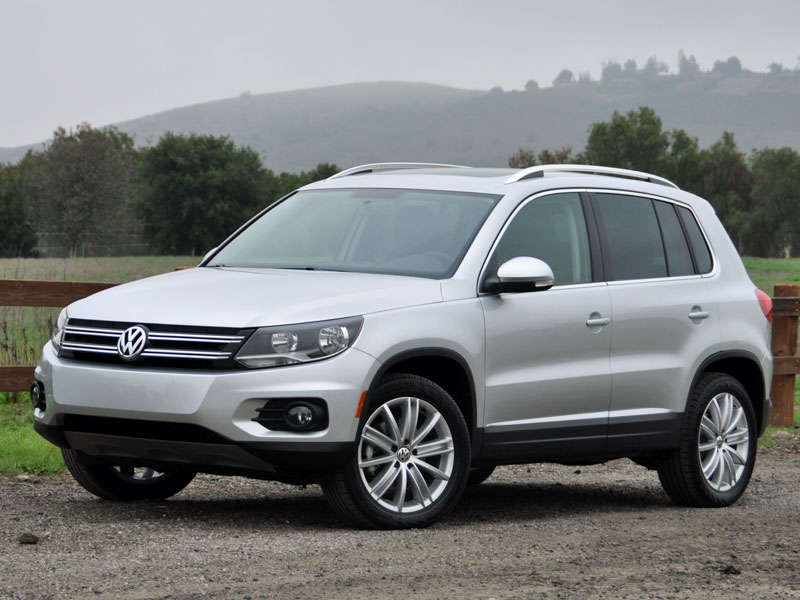
2014 Volkswagen Tiguan Review and Road Test: Design
- SE Appearance Package
- Tiguan R-Line added to lineup
Examine a 2014 Volkswagen Tiguan in profile or from a rear-quarter perspective and it is instantly clear that this SUV could never serve as the star vehicle in a remake of a Sir-Mix-Alot video. That’s because most of its visual largesse sits over its front wheels. To resolve this imbalance, the Tiguan could definitely use an extra foot or so of sheet metal and greenhouse beyond the rear doors, which would improve the Volkswagen’s looks while at the same time resolving a critical flaw in this SUV’s capabilities. More on that in the next section.
In the meantime, it’s important to keep in mind that the German-built Tiguan was originally designed to serve European buyers, and as such to squeeze with ease into cramped parking spaces.
Speaking from experience, I can tell you that it is super-easy to park this VW. You must, however, keep the wheels away from curbs. My SEL test vehicle had the 18-inch “New York” wheel design, which features spokes that bow out past the tire sidewalls, making them susceptible to scraping on taller curbs. Consider yourself warned.
The Tiguan’s Germanic origin is clearly evident inside, where serious instrumentation and somber materials come together in relentlessly unified fashion. Aside from metallic-finish bits and pieces, my test vehicle’s black interior was almost bleak in appearance, which is one reason I prefer the Beige leatherette color. So-equipped, the Tiguan retains its glare-reducing black upper dashboard and door panels as well as its black carpeting, giving the Tiguan an upscale, two-tone cabin appearance.

2014 Volkswagen Tiguan Review and Road Test: Comfort and Cargo
- Tiguan SE adds standard leatherette seat upholstery
- Tiguan SE adds standard heated front seats
Because the Tiguan is designed to deliver maximum interior space in as small a package as possible, Volkswagen constructs the SUV on a stubby platform with a surprisingly small footprint. Compared to a VW Golf, the Tiguan’s wheelbase and width measure about an inch longer and wider, and from stem to stern the crossover SUV is just 9.1 inches longer than the 5-door hatchback. So how does the automaker cram so much extra room into the Tiguan? The same way urban real-estate developers make best use of small parcels of land: Volkswagen built up.
As a result, the Tiguan’s firm and supportive front chairs provide an upright seating position facing a steep windshield and a simple and shallow dashboard. Manual height adjusters and, in many Tiguan models, power adjustable seatbacks help to improve comfort levels, and the tilt/telescopic steering wheel ensures a proper driving position. Volkswagen also supplies padded upper door panel trim that is comfortable to elbows, and the soft center armrest adjusts for height while also sliding forward for added comfort.
If you’re relegated to the rear seat, don’t worry. You’re going to be comfortable. Like, all-day road-trip comfortable. For such a small SUV, the Tiguan’s back seat is like a limousine. As is true of the front seats, the rear seat provides a firm and supportive cushion, lots of thigh support, and an excellent view out. Unexpectedly, legroom is also generous, and foot room under the front seats is positively enormous. Plus, Volkswagen densely pads the front seatbacks and even the bottom front seat frame trim to protect any knees or shins that might come into contact with them. Get the SEL or R-Line trim level, and the panoramic sunroof extends all the way back, creating a very open, very airy, and very inviting back seat.
Nothing good in life is free, though, and where Volkswagen makes the biggest concession with the Tiguan is with regard to cargo space. Pop the rear hatch, and you’ve got 23.8 cubic-feet of volume for your things. That’s better than a sedan, of course, but falls short of most SUVs and even some compact cars and multi-purpose vehicles. Volkswagen could probably remedy the cargo space problem by mounting the rear seat further forward, but then the Tiguan would lose one of its most appealing traits, and that’s genuine room and comfort for adults riding in the back seat.
Fold the rear seat down, and maximum cargo capacity measures 56.1 cu.-ft. Again, that’s a small number, well behind segment leaders. Therefore, if you’re interested in a compact crossover SUV for its cargo space and added utility, think carefully about whether or not a Tiguan is going to meet your requirements.
Ending on a positive note, though, Volkswagen equips the Tiguan with a fold-flat front passenger’s seat to help accommodate longer items with the tailgate closed.
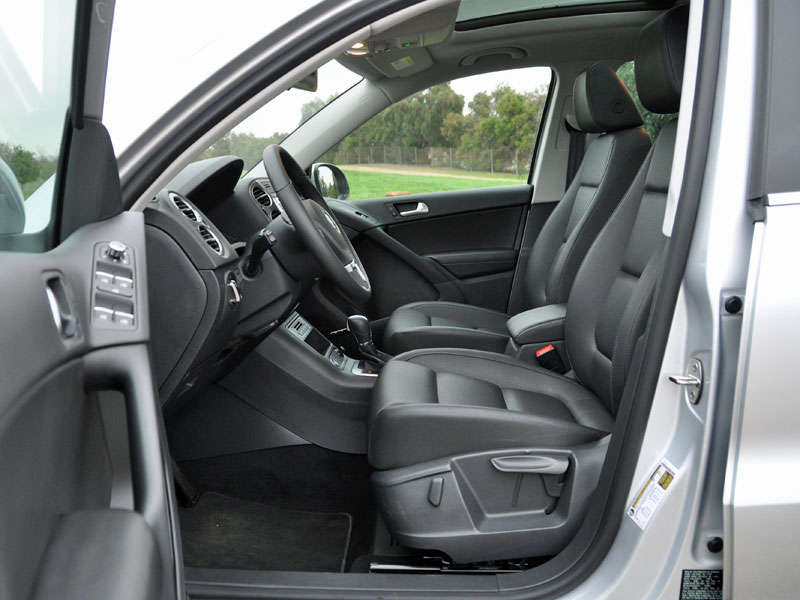
2014 Volkswagen Tiguan Review and Road Test: Features and Controls
- VW Car-Net technology added for most models
- Tiguan SE gains MDI cable and iPod connectivity
- New Fender premium audio system for SEL and R-Line
Most of the Volkswagen Tiguan’s controls are easy to locate and use, and the gauge cluster is a model of clarity. At night, the gauges and information displays are illuminated in white while ancillary controls are illuminated in red, just like an Audi. Oh, and check this out. All four of the windows offer one-touch opening and closing, and so does the panoramic sunroof.
My Tiguan SEL test vehicle included Volkswagen’s touchscreen infotainment system, including navigation, HD Radio, satellite radio, and a Fender premium audio system. I like that Volkswagen offers a big power and volume knob and a tuning knob, even if the tuning knob is located in an unconventional spot. However, I’d definitely like to see a larger screen, and if you want to retain your sanity I recommend programming the 18 radio station pre-sets to avoid lots of confusion and frustration.
Pairing a smartphone required use of the manual, and even then it wasn’t clear to me that I should be consulting the information display between the gauges rather than the infotainment display in order to get my phone connected to the system. Once that was clear, it was easy to connect my iPhone to the Tiguan.
Volkswagen offers numerous of display options for the navigation system, and it’s fairly easy to program. Car-Net telematics is new for 2014, and includes six free months of service. One reason you might want Car-Net is that it includes an Automatic Crash Notification system that helps to speed rescuers to the scene of an accident following an airbag deployment.
Another feature of Car-Net, available once you’ve downloaded the mobile app to your smartphone, is Last Parked Location, which helps you find the Tiguan in a crowded parking lot. Not that I’ve ever needed something like that.
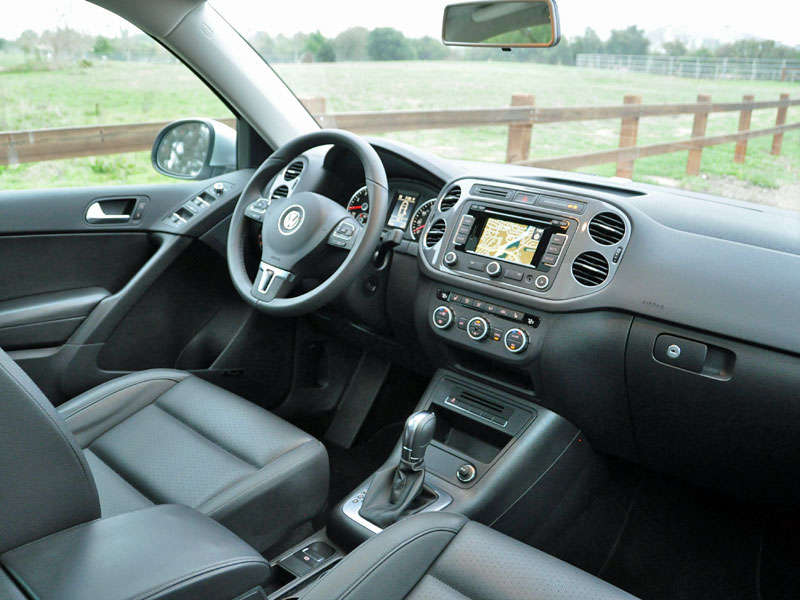
2014 Volkswagen Tiguan Review and Road Test: Safety and Ratings
- Car-Net connected services including Automatic Collision Notification and SOS button
Volkswagen likes to promote what it calls its Intelligent Crash Response System. Following a collision, this system activates the hazard lights, unlocks the doors, and cuts the supply of fuel to the engine, reducing the potential for a fire while making it easier for rescuers to find and access the SUV. This is great, of course, but many automakers offer this kind of system. What few competitors do supply, however, is the Tiguan’s brake disc wiping feature that dries them in wet conditions in order to improve braking response and promote shorter stopping distances when it is raining.
Upgrade yourself to the Tiguan SE for a standard Car-Net telematics system that includes Automatic Collision Notification and an emergency SOS button. A reversing camera is installed in conjunction with the SE Appearance Package, while the Tiguan R-Line is equipped with rain-sensing wipers and bi-Xenon headlights with an Adaptive Front Lighting System.
If you’re wondering what safety features the Tiguan does not offer, no matter how much you might want them, here’s the list: blind-spot monitoring, lane departure warning, forward collision warning, or a collision prevention system.
It would be nice if Volkswagen offered more safety technology for the Tiguan, and while they’re at it, engineers ought to improve crash-test performance. In tests conducted by the National Highway Traffic Safety Administration (NHTSA), the Tiguan earns a 4-star overall crash protection rating. However, the individual rating for front passenger protection in a frontal-impact collision measures 3 stars.
Based on Insurance Institute for Highway Safety (IIHS) testing, the Tiguan earns the highest rating of “Good” in all assessments except the small overlap frontal impact test, for which the SUV rates “Marginal.” Note, though, that this performance matches the Honda CR-V and is better than both the Ford Escape and Toyota RAV4, all three competing SUVs ranked very high on compact crossover sales charts.
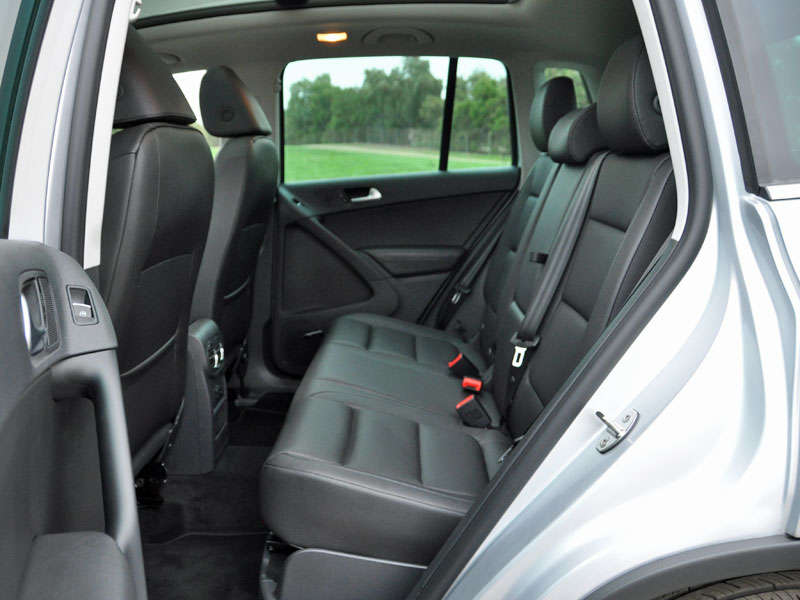
2014 Volkswagen Tiguan Review and Road Test: Engines and Fuel Economy
- Paddle shifters standard for Tiguan R-Line
Volkswagen’s ubiquitous turbocharged 2.0-liter 4-cylinder engine is installed under the Tiguan’s hood, where it makes 200 horsepower and 207 lb.-ft. of torque while burning premium fuel. The EPA says the Tiguan is rated to get 23 mpg in combined driving, and my front-wheel-drive test vehicle delivered 23.3 mpg, slightly exceeding expectations.
There are a few things to keep in mind with this engine. First, because it is turbocharged, it’s going to feel stronger at elevation than most competing models, something to keep in mind if you live at elevation or you like to head to the mountains on a regular basis.
Second, the power spread is a broad one, and while the Tiguan never really feels fast, it’s never slow. Peak torque is available from 1,700 rpm all the way to 5,000 rpm, and then peak horsepower kicks in from 5,100 rpm to 6,000 rpm. What that basically means is that the Tiguan’s engine is making maximum torque or maximum horsepower over the majority of the engine’s rev range, and that translates into a responsive SUV.
Third, the engine is bolted to a 6-speed automatic transmission with a Sport driving mode and a manual shift gate featuring an intuitive shift pattern. In regular drive mode, the transmission upshifts early, but the shifts are somewhat leisurely, and in this mode the transmission has a tendency to hunt as it attempts to balance power requirements with fuel economy, a quality that irritated my wife to no end. Choosing Sport mode resolves these issues by holding engine revs longer and executing crisper gear changes, but then, of course, the Tiguan consumes more gas.
Personally, I thought the transmission was agreeable enough. Your results may vary.

2014 Volkswagen Tiguan Review and Road Test: Driving Impressions
Get yourself situated behind the Volkswagen Tiguan’s steering wheel, and prepare to enjoy one of the more entertaining driving experiences offered by a compact crossover SUV. We’ve covered the engine and transmission in the previous section, so I’ll move on to driving dynamics.
In my opinion, the Tiguan’s electric steering is excellent, and should serve as a model for how this kind of technology is properly engineered. On center, the steering feels solid and secure, giving the Tiguan a planted feel at extra-legal speeds. Off center, the steering feels natural and proves precise, delivering crisp response combined with an ability to fine-tune input and place the SUV exactly where you want it. Better yet, the leather that Volkswagen wraps around the steering wheel is very smooth, making it easy to shuffle steer if that’s your thing.
You might be inclined to do just that in a Tiguan, because the handling is remarkably good for something that sits up so high on such a stubby wheelbase. At first, the Tiguan’s body roll might cause concern, but thanks to the excellent steering, expert suspension tuning, and big 18-inch wheels, my test vehicle proved itself predictable. A Tiguan’s handling prowess isn’t equal to a GTI, of course, but you could credibly call it the GTI of crossover SUVs.
Better yet, the impressive handling doesn’t come at the expense of ride quality. A Tiguan soaks up lots of ugliness at the road surface, the wheels remaining planted to the pavement while the suspension effectively communicates information about the road surface without smacking you in the backside with it. Plus, except for really granulated road surfaces, the Tiguan is remarkably quiet inside as far as engine, wind, and road noise are concerned.
If there’s an area where Volkswagen could improve this SUV, it’s with regard to brake pedal feel in certain driving situations. The brakes themselves are fine, and stood up to plenty of abuse on the twisty mountain roads near Malibu, California. I also appreciated an ability to bring the Tiguan to smooth, drama-free stops at intersections. But in variable braking situations, which are common on traffic-clogged L.A. freeways, the pedal lacks feel and response, making it harder to adjust brake pressure as is necessary.
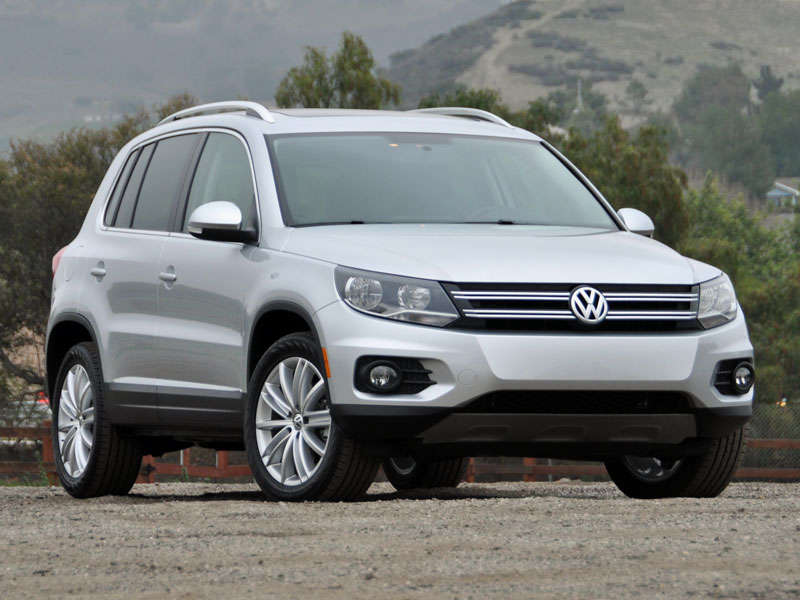
2014 Volkswagen Tiguan Review and Road Test: Final Thoughts
Though the Volkswagen Tiguan is getting along in years, it remains an impressive little crossover SUV, and a terrific alternative to what everyone else is driving.
There are three main downsides to buying one, though. First, the cargo space is comparatively small, even if passenger space is roomy and comfortable at the same time. Second, Volkswagen needs to improve this SUV’s crash-test scores, even if it matches or bests the compact crossover SUV segment sales leaders in IIHS assessments. Third, Volkswagen requires premium fuel for the Tiguan’s turbocharged engine. In my neighborhood, that translates to 20 extra cents per gallon.
If these flaws don’t bother you much, then you’re going to love the Volkswagen Tiguan.
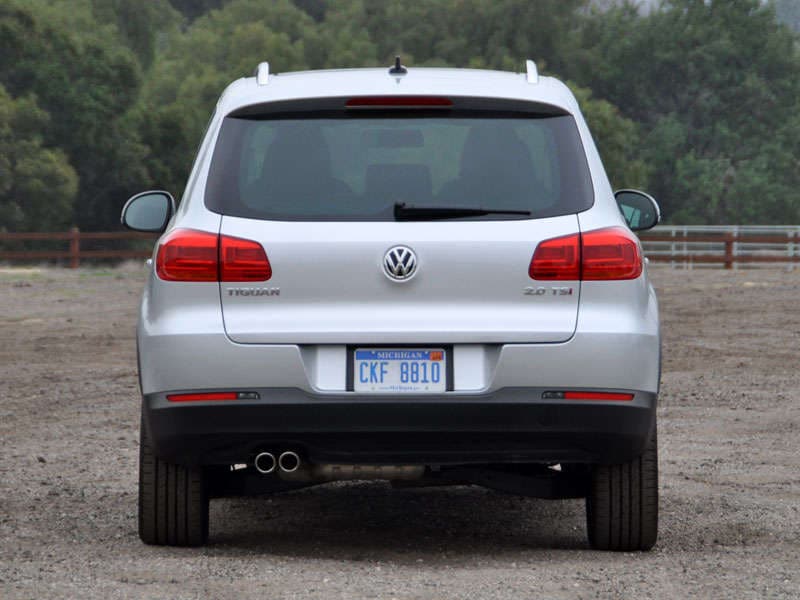
2014 Volkswagen Tiguan Review and Road Test: Pros and Cons
- Lots of fun to drive
- Nimble and easy to park
- Gets good gas mileage without trying
- Surprisingly spacious and comfortable
- Car-Net connectivity system
- Tight cargo space for a crossover SUV
- Lacks modern safety technologies
- Needs to improve crash-test ratings
- Requires premium fuel
- Relatively high price tag
Volkswagen supplied the vehicle for this review
2014 Volkswagen Tiguan SEL photos by Christian Wardlaw
